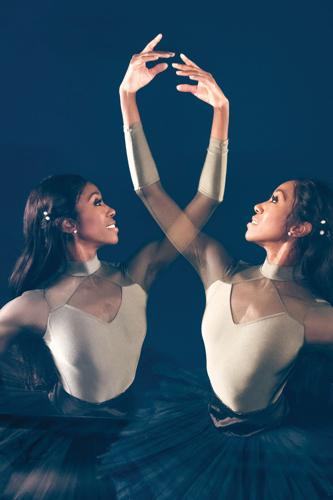
Nashville Ballet Company Dancer Claudia Monja
Ballet is a centuries-old art form, marked by beauty, grace and exquisite storytelling. And while there will always be a place for great classical works such as Swan Lake and The Nutcracker, the language of ballet is clearly changing — embracing new voices, fresh ideas and even different body types.
“The truth is that ballet has been shifting for years,” says Nick Mullikin, artistic director and CEO at Nashville Ballet. “It’s changed dramatically from when Marius Petipa originated choreography in his Swan Lake to what we do now. The demands have become far more athletic, more about strength. So some of the stereotypical body types of the 1960s, ’70s and ’80s have given way to those who have the strength and physicality that allows them to be versatile, not only in ballet but also in other styles of dance.”
Beyond the changing physical demands, Mullikin points to issues of diversity, equity and inclusion as driving the evolution of ballet. Whether it’s through seasonal programming or increased arts access, he says the company is always striving to “give audiences the chance to find themselves within the art.”
“The different perspectives that were once relegated to the sidelines are now being included much more readily,” Mullikin says. “And yes, it took a lot of people recognizing where we, as a field, were coming up short. But we’re starting to have that moment of growth. I wouldn’t say that we’re there, but there’s certainly an opportunity for us to listen and continue to evaluate our practices and processes.”
For example, at the beginning of each new season, Nashville Ballet fits all of its dancers with custom tights and shoes that match their individual skin tone. Traditional pink dance wear — long the standard in ballet — simply no longer reflects the company’s mission to create a more inclusive community.
“So the aesthetic is changing,” he says. “We’re no longer satisfied with this homogenous, Eurocentric aesthetic of beauty onstage. The real beauty lies with the individual dancer — who they are, and how they’re a part of our community. That’s always been Nashville Ballet’s aspiration — to be a true reflection of our community, as much as we can.”
That means celebrating diverse stories and perspectives, and opening the door to new ideas. But when it comes to the actual language of ballet, which Mullikin defines as “the structure of the technique,” the changes are often subtle — the way the arms are shaped, or the way the knees are bent.
“In ballet, we have no words — we have only our gestures and body position to convey the story. Pantomime is part of that. But how do we change the shape, while still holding onto the proper technique? How do we create new pictures, so that stories can be told in a different way — that’s the evolution of the language of ballet.”
Such language was on full display in February with Nashville Ballet’s Attitude — a popular program known for showcasing unique collaborations and contemporary movement. This year’s lineup featured three world premieres, including Weep by the award-winning choreographer Yusha-Marie Sorzano.

Nick Mullikin, artistic director and CEO at Nashville Ballet
“We’re seeing choreographers take traditional ideas of structure in choreography and sort of pull them apart,” Mullikin says. “We saw a ton of that in Yusha’s work, where the group came together, sometimes in a really amorphous state — because that’s honestly just more interesting than a perfect circle or a straight line. For me as artistic director, that’s what’s really fascinating about this particular season. It demonstrates that range of form and structure, while also being able to dissect it. It also highlights the versatility of these dancers. They aren’t just doing one thing — they’re doing all the things.”
Mullikin points to company dancer Claudia Monja, who wowed audiences with her evocative solo in Weep, as a perfect case in point.
“There’s a moment where she drops down into a second position, and she’s turned out — and that’s a classical ballet position. But the way she uses her upper back and her body and face is very contemporary. It’s the exact same kind of step done in a way that allows us to feel something completely different. That’s the evolution we’re talking about, and Claudia has absolutely embraced it.”
For Monja — who was born in Havana, Cuba, and danced with Cuban National Ballet, Ballet de Camagüey and Joburg Ballet before joining Nashville Ballet in 2021 — it’s all about connecting with audiences.
“It is a very emotional and deliberate process to feel the connection with the audience when casting the story through movement,” Monja says. “I want the viewer to be enticed and feel the passion, the pain, the context of the character who is communicating through movements and harmony.”
Monja says that by working with different techniques and movements, she has developed “a new vision of ballet.”
“Weep is the perfect example of the changing language of ballet,” she adds. “It was a testament to how a student of the arts who is classically trained can interpret and embrace almost opposing movement expressions. Classical movements are pronounced differently to the new-age contemporary expression. Absorbing new movements into my repertoire permits me to create a signature style of movement suited to me — a hybrid movement, if you will.”
And perhaps it’s this hybrid approach that makes Mullikin so hopeful for the future.
“One of the things that really excites me is that we have the ability to tell so many different stories through dance,” he says. “Classical ballet has a place within the canon, but we also recognize that ballet can’t stay stagnant. Just like our community, we’re growing and changing, and there’s something really inspiring about that.”
Looking at Nashville Ballet, the city’s contemporary dance scene and opportunities to learn and practice different styles




